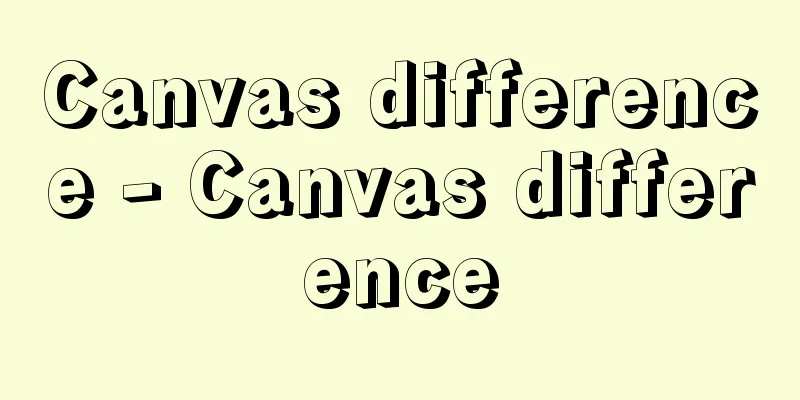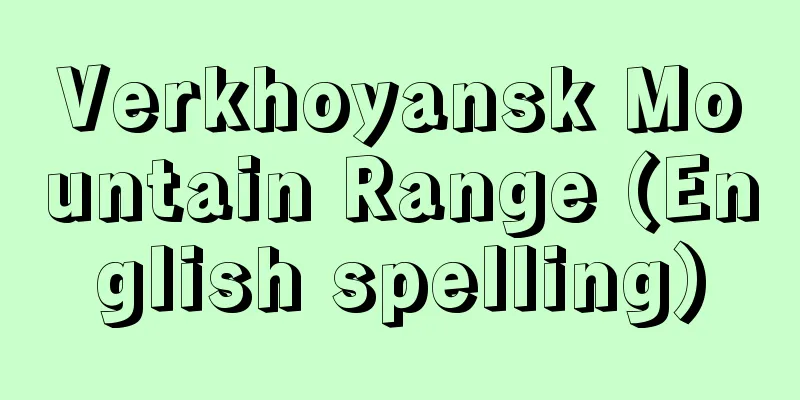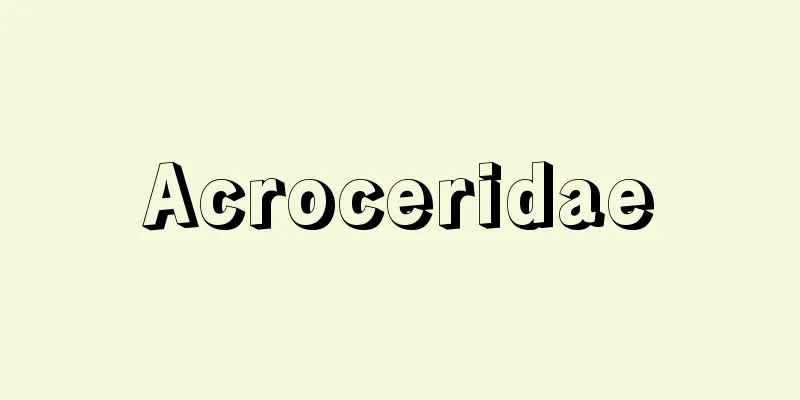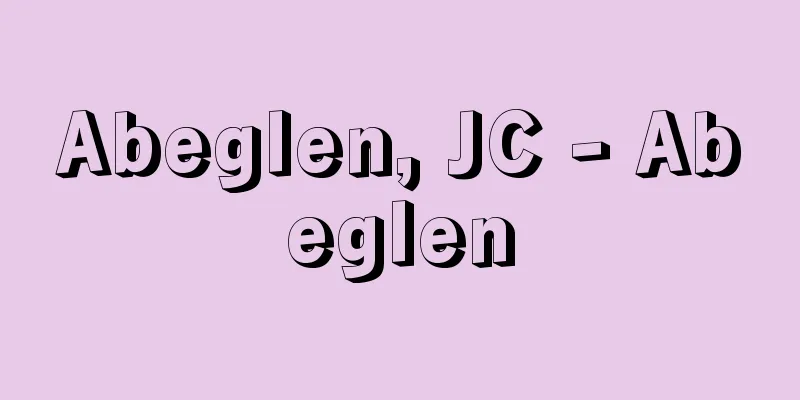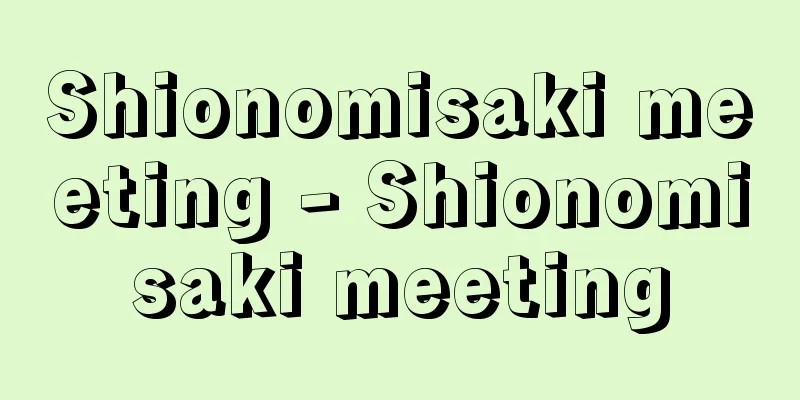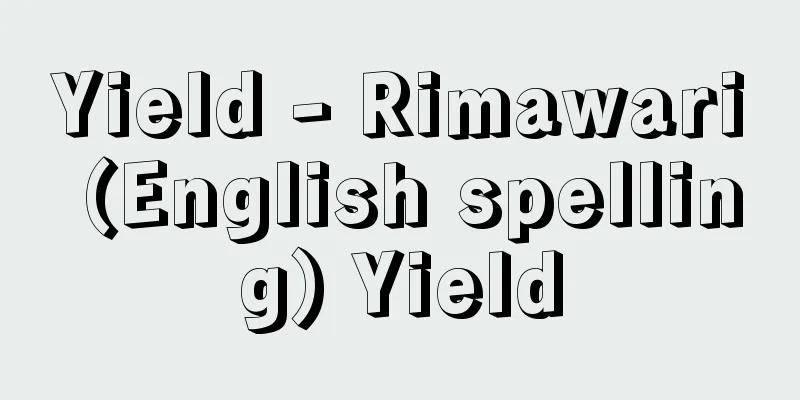Kanji - Kanji
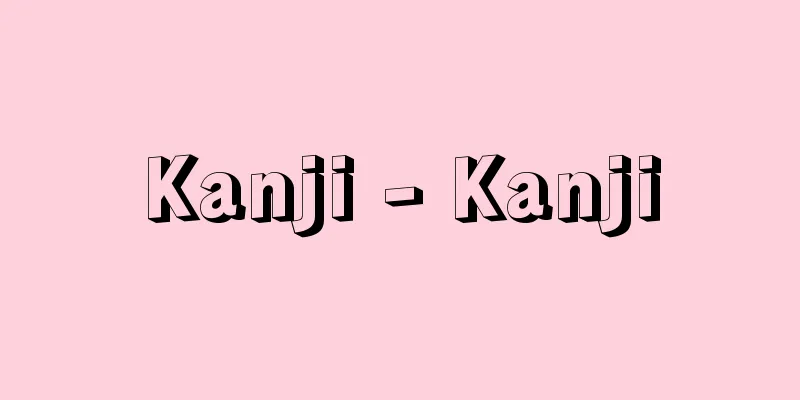
|
One of the ideograms. It was originally created in China to write Chinese, but later spread to Korea, Vietnam (Annam), and other neighboring countries, where it was used to derive characters like Japanese hiragana and katakana, and influenced characters such as the Western Xia, Khitan, and Jurchen scripts. In Vietnam, a unique character based on Chinese characters, "Chunon," was invented, but after it became a French colony in the 19th century, the Romanization of the alphabet progressed and the character fell into disuse. In Korea, there was a lot of influx of Chinese words, and Chinese characters were used for a long time as the official characters and literary language. In the past, readings of Chinese characters, rito readings based on Chinese characters, and reading marks similar to Japanese katakana were also used, but in recent times, in North Korea, Chinese characters were completely abolished in 1949 and only Hangeul was used, and in South Korea (Republic of Korea), the trend toward Hangeul is also remarkable. In mainland China, a movement to reform the national characters began around the time of the Republic of China Revolution, but after the People's Republic of China was established, the "Draft Plan for Simplifying Chinese Characters" was published in January 1955, and the characters were simplified, a policy that has been further promoted ever since. Furthermore, in 1957, the Plan for Pinyin (Romanization of Chinese) was published, and the old Chinese characters are now only used in Taiwan, Korea, and parts of Japan. Looking at the structure of kanji, there are characters that represent the shapes of objects, abstract concepts, and combinations of these. There are over 50,000 characters in total, but only 6,000 to 7,000 are actually used in literature, and only around 3,000 are commonly used in everyday life. [Yutaka Tsukishima] originThere are several legends about the origin of Chinese characters, such as that Cangjie, a historian of the Yellow Emperor, created them after seeing bird footprints, or that Paoqi created them based on the Eight Trigrams, but it is difficult to identify a specific creator, and it is probably best to consider them as having arisen spontaneously. The oldest surviving Chinese document is the "oracle bone inscription" carved on turtle shells and cow bones, excavated from the Yin Ruins, and is thought to date to around the 15th century BC. The characters are very archaic, close to hieroglyphics, reminiscent of the shapes of real objects, and often contain divination results. The next oldest are the "bronze inscriptions," carved on ancient copper vessels, and created mainly during the Zhou Dynasty (12th to 3rd centuries BC). However, the characters in these bronze inscriptions were diverse and not uniform. According to legend, a man named Chu, the Grand Historian of King Xuan of the Zhou dynasty, revised the old style of characters and created the "Zhuwen" (籀文), which later came to be called the "Daiten" (大碆) during the Qin dynasty. During the Spring and Autumn Period and the Warring States Period toward the end of the Zhou dynasty, various different characters were used in different countries, but when the Qin dynasty unified the country (221 BC), it unified the characters throughout the country and the Prime Minister Li Si introduced the "Small Seal" (小碆), a revised version of the Zhuwen, to the world, and banned characters that did not fit it. During the Qin dynasty, "Clerical Script" (麗書) was also developed. It is said that this was invented by a man named Cheng Miao (邈) while in prison, and it was a practical character that was revised for the convenience of office work. Even during the Han dynasty (2nd century BC to 3rd century AD), "Daiten", "Small Seal" and "Clerical Script" continued to be used from the previous era. The commonly used style of writing was clerical script, but even within that there were various styles. These can be seen in existing inscriptions and wooden tablets excavated from the Western Regions, and include the appearance of "eight-quarter" style, in which the lines are wavy and the end of the brush is bent, as well as a style that is thought to be the origin of regular script. Also, from the Western Han dynasty, a style of cursive writing called "zhangcao," in which each character is separated, appeared. By the time of the next Wei-Jin Six Dynasties (3rd to 6th centuries), regular script had developed, but running script and continuous cursive script were also in use. These are known from law books and manuscripts excavated from Dunhuang. In this way, regular script, running script, cursive script, and other styles had all emerged by the beginning of the Tang dynasty (7th century). At that time, there were many different styles of characters in regular script, but when Yan Shigu corrected errors in the text of the classics, he extracted the different characters and created the "Yan family characters," and his descendant Yan Yuansun organized them and wrote the "Ganlu characters." This distinguishes between traditional, common, and vulgar characters and shows their uses. After this, the number of different characters gradually decreased, and after the Song dynasty, as printing developed, standard characters became widespread, but some different characters were still used in manuscripts. Most of the typefaces currently in use are based on the characters published after the Ming dynasty (14th to 17th centuries). Recently, in the People's Republic of China, new characters called simplified characters have been established and are in common use since 1955, but these are the result of simplifying the strokes of old characters and reusing homophonetic characters with fewer strokes. Meanwhile, in Japan, 1,850 kanji for common use were published in 1946 (Showa 21), limiting the number of characters, and in 1949, the "List of Kanji for Common Use" was published, officially recognizing abbreviated characters. In 1981, 1,945 kanji for common use were published again, including abbreviated characters. [Yutaka Tsukishima] The Six Chinese CharactersThe six categories of Chinese characters that explain their structure and usage are called "Rokusho (Six scripts)." They are pictographic, ideographic, compound ideographic, phono-semantic, inflected, and borrowed. The first four are the ways in which Chinese characters are constructed, and the last two are the ways in which they are used. "Pictographic" characters are those that mimic the shape of an object, and are similar to paintings, with a strong hieroglyphic character character. They often represent visible objects, such as "sun," "moon," "mountain," "water," "tree," "fish," and "horse." They are the most basic of Chinese characters, but there are only a few characters in total. However, other Chinese characters are often created based on them using other construction methods such as ideographic, compound ideographic, and phono-semantic. "Ideographic" characters represent abstract concepts that cannot be copied, such as numbers such as "one," "two," and "three," and "upper" and "lower." Numbers are created based on the number of horizontal lines, with "upper" being created by adding a "・" to the top of a "-" and "lower" being created by adding a "・" to the bottom of a "-". "Composite I" is a combination of two or three characters, and their meanings are also combined. "Hon" is the overlapping of "fire", "I" means the place where "people" stand, and "East" is said to mean the direction of the sun among "wood". "Phonetic" is also called "harmonious voice" and is a combination of two characters, but a new character is created by taking the sound from one and the meaning from the other, and thus the sound and meaning of the new character are shown. In the case of "江" and "河", "氵" on the left means "water", and "工" and "可" show the pronunciation. In the case of "問" and "聞", "門" on the outside shows the pronunciation, and "口" and "耳" on the inside show the meaning. There are many examples of "phono-semantic", and the majority of Chinese characters are created by this. All Chinese characters are created using the above four types, but some Chinese characters are not only used for the original purpose they were created for, but are later converted to other meanings. "Transferred meaning" refers to when a word changes from its original meaning to a new one, and instead of creating new characters, the original characters are repurposed to express the new meaning. For example, "rei" originally meant a command, but it has since come to mean a person who issues commands, a chief official, etc. "Gaku" originally meant music, but since music entertains people's hearts, it is used to mean "enjoy," and the sound has also changed to "raku." Since music is something people like and wish for, it is also used to mean "pray," and the sound has changed to "geu" (gyou). Next, "kashaku" (borrowed words) are used for other words with the same sound, regardless of their meaning. For example, "kawa" (leather) means "leather," but with the same "kaku" sound, it is also used to mean "to change." "Mimi" (ear) originally meant "mimi," but with the sound of "ji," it is used as a particle in the form of "nomi" (only). Additionally, in ancient China, the sounds of foreign names of people and places, such as those from India and Central Asia, were transcribed into Chinese characters such as "shindoku" (poison) and "amida" (abbreviated form). This can also be seen as a type of "kari" (borrowing). [Yutaka Tsukishima] Kanji ShapeWhen the shape of a kanji character can be divided into two parts, such as left and right, top and bottom, inside and outside, the left part is called the "radical," the right part is called the "side," the top part is called the "crown," and the bottom part is called the "leg." In addition, something that spans the top and left parts is called "hanging," something that spans from the left part to the bottom is called "circling," and something that sandwiches the top from both sides is called "structure." Examples of "radicals" include "亻" (person, person radical), "口" (mouth radical), "忄" (heart, heart radical), "氵" (water, water radical), and "犭" (dog, animal radical). Examples of "side radicals" include "刂" (sword, sword), "阝" (village, large roof), and "隹" (an old style of character for "bird", furutori). Examples of "crowns" include "宀" (u-kanmuri, umbrella-shaped) and "艹" (kusa-kanmuri, grass radical, soukou). Examples of "legs" include "灬" (rekka, raging fire). Examples of "drops" include "广" (red and red spots) and "疒" (mountain dripping). Examples of "circle" include "辶" (shinnyo, shinyō). Examples of "structure" include "gate" and "囗" (kunigamae). Dictionaries that classify and arrange Chinese characters according to their shapes have been created since ancient times, and when radicals such as those mentioned above are added as entries in these dictionaries, they are called "radicals." The number of radicals has varied from ancient times to more than 500 and even less than 100 depending on the dictionary, but the 214 radicals established by the "Kangxi Dictionary" are widely used today. [Yutaka Tsukishima] Kanji soundsEach Chinese character has a certain pronunciation. In China, pronunciation is called "kanji on", "zi on", "on" or "koe", but it has changed and differed greatly depending on the era and region. Furthermore, when Chinese characters were introduced to Korea, Japan, Vietnam and other countries, each country had its own unique zi on. In Japan in particular, in addition to zi on, a unique way of reading the characters was created in which Japanese translations were fixed as Chinese characters, and these were used in conjunction with zi on. These are called "wakun", "kun" or "yomi". Z zi on is classified according to initial consonant and rhyme (the entire Chinese character rhyme minus the initial consonant). The types of initial consonants are roughly divided into 23 types in "Yunkyo", which is said to be based on sounds from around the 10th century, and the number of rhymes is classified into 206 rhymes with four tones in "Setsui", which is said to be based on northern sounds from around the 7th century. However, in later times the number was reduced to 107 rhymes in the "Jinshi Libu Rhymes," and one rhyme was removed from that to make 106 rhymes, which is still used when composing Chinese poetry to this day. Tones (accents) are usually divided into four tones (pingsheng, shangsheng, qusheng, and rusheng), of which the rush sounds ending in -p, -t, and -k do not exist in the standard pronunciation of modern China, but did exist in the pronunciation of ancient Chinese characters, and remain in some dialects to this day, and in a modified form in the pronunciation of Japanese Chinese characters. In addition to the four tones, ancient Japanese Chinese characters were sometimes divided into six tones, eight tones, etc. [Yutaka Tsukishima] Types of Japanese Kanji soundsIn Japan, there are Japanese kanji readings (kanji on, on), but in addition, readings based on Japanese translations were established as kanji and became Japanese readings (kun, readings). For "生" (life), "sei" and "shou" are kanji on, and "umu," "ikiru," "nam," and "ki" are Japanese readings. Among the kanji on, there are Go on, Kan on, and To on (Song on), among others. For "行" (practice), Go on is Gyo, Kan on is Kou, and To on is An. Go on is the sound of the region along the Yangtze River in China, which was probably introduced via Korea, Kan on is the sound of the Chang'an (now Xi'an) region in northern China, which was introduced after Go on, and To on is said to have been introduced after the 10th century. Wakun is a reading unique to Japan, but its establishment probably dates back to before the 7th century. Go-on has been used since ancient times to read Buddhist scriptures, and many of the names of cultural objects and Chinese words that were introduced into the Japanese language very early are written in Go-on. What was called "Wa-on" has characteristics similar to Go-on. Since the Nara period, the Imperial Court has made efforts to popularize Kan-on as "Seion" and it has been used in Chinese books and some Buddhist books, but it has not yet eliminated "Go-on", which had been used before, and both have been used together. Since the Meiji period, many Chinese words using Kan-on have been created to translate new cultural objects and philosophical and academic terms imported from Europe and America, and some words use both Kan-on and Go-on, such as "gengo" ("gen" is Kan-on and "go" is Go-on). This type of combination is not often seen before the Edo period. "Tang-on" is also called "Song-on" and was mainly introduced after the Kamakura period, and is said to be the sound of southern China. There have been some variations over time, and examples include its use in Zen Buddhist scriptures and as the names of certain objects, such as 'kankin' (reading sutras), 'andon' (lantern), 'futon' (futon), and 'fushin' (construction), but they are few in number. In addition, there are what are called "conventional pronunciations," which are not any of the above. Examples include "yu" (import) as "shu" (correctly pronounced "shu") and "mo" (consumed) as "kou (correctly pronounced "kau"), and while many of these are misreadings due to their side groups, they are generally accepted. In ancient times, there was also inconsistency in the way Chinese characters were written, for example, the sound of the final n was written as "ni" or "i," whereas in later times it was written as "n." Words such as "zeni" (money) and "reizei" (cold spring) are thought to be remnants of this. There are also words in which Chinese characters and Japanese pronunciations coexist within the same word. Words such as "juubako" (a box with a Japanese pronunciation on top and "engumi" (marriage) on the bottom are called "juubako readings," while words such as "yutou" (a bowl with a Japanese pronunciation on top and "yutou" (a bowl with a red book) on the bottom are called "yuoke readings." Examples can be found from the Heian period onwards, but from the Middle Ages onwards it has been used frequently, especially in slang. [Yutaka Tsukishima] The history of kanji in JapanThe introduction of Chinese characters to Japan is said to date back to the 1st century AD, but extant documents written in Japan date from the 5th century onwards. Initially, classical Chinese was written only in Chinese characters, but among these, phonetic writing of Japanese place names and personal names (Man'yōgana) had been used since ancient times, and from the 9th century onwards, "hiragana" and "katakana" were created as characters unique to the Japanese language. Until the Nara period (8th century), all documents written in Japan were written in Chinese characters, but not only were there works written in formal Chinese characters, such as the "Nihon Shoki," but there were also works written in "Wakasa Kanbun" (Japanese-style Chinese characters) with Japanese elements, such as the "Kojiki." In addition to the use of Man'yōgana, which consisted of one sound per character, as in the "Kojiki" and "Nihon Shoki," when writing waka poetry and other works, there was a style of writing in which both the Japanese readings of Chinese characters and Man'yōgana were used, as seen in the "Man'yōshū." Among the Man'yōgana, "kunkana," which consisted of the sounds of the Japanese readings, was also used, along with "onkana," which consisted of the sounds of the Chinese characters. In the Heian period (9th to 12th centuries), hiragana and katakana were invented. At first, hiragana was often used by itself to write sentences, but later, it gradually became more common to mix in kanji, and in the Middle Ages, "mixed kanji and hiragana writing" became popular. At first, katakana was only used as an auxiliary means to mark up readings of classical Chinese texts, but early on, a style of mixed kanji and katakana writing modeled on the reading marks in classical Chinese texts emerged. This gradually developed among monks and other scholars, and by the 12th century, katakana had come to be widely used to write not only Buddhist documents but also tales. On the other hand, the custom of writing waka poetry using only katakana has existed since the 10th century, and although it was probably limited to personal notes at first, it eventually began to be used in anthologies and other writings. This reflects the fact that katakana developed and became more independent and social, and gained the power to rival kanji. The use of katakana in commentaries that note the pronunciation and reading of kanji, such as Fujiwara no Kinto's Daihannyakyo Jisho (completed around 1032), is also part of this series of phenomena. In this way, from the Middle Ages onwards, in addition to classical Chinese writing written entirely in kanji, writings that mixed kanji with hiragana and katakana were used in parallel, but among these, kanji always bore the highest value as a character, and were called "mana" (real name) in contrast to kana (kanna = temporary, meaning "na"), and were the core of the characters that represented the national language. One example of this is the appearance of "Manabon," documents originally written in kana that were later converted to kanji. Examples include "Manabon Ise Monogatari" and "Manabon Heike Monogatari." Words unique to Japan that could not be expressed in the original kanji were usually written in kana, but the creation of "kokuji," which resemble the shape of kanji, is another example of this type of situation. Examples include "sakaki," "hanashi," "touge," "kogarashi," "suberu," "tsuji," "komu," and "tara." Many of these are combinations of two or more kanji depending on their meaning. There are also cases where two characters are combined to form one, such as "maro" (male + male) and "moku" (wood + craft). In addition to the original meaning of the kanji, there are also Japanese readings that have been assigned to meanings determined in Japan. For example, "hagi" originally meant "mugwort," but in Japan it is the name of an autumn flower, and "oki" originally meant "empty" or "deep," but in Japan it refers to the ocean far from the shore. Furthermore, there are new kanji characters that were created as a result of the import of Western culture, such as "byo" (pin), "sen" (gland), and "kilometer." [Yutaka Tsukishima] The Present and Future of Japanese KanjiFor about 1,500 years since Chinese characters were introduced from the continent, Japan has respected Chinese characters as the core of its writing system. However, after the Meiji period, Western rationalist thought led to the insistence that Kana or the Roman alphabet, which are phonetic characters, should be used instead of Chinese characters, and after the Pacific War, a national character policy was implemented along these lines, and 1,850 common kanji characters were promulgated in 1946 (Showa 21). However, opposition to this policy grew stronger, and the number of on-yomi and kun-yomi characters was increased, and the number of characters was also increased, resulting in the promulgation of 1,945 common kanji characters in 1981. The policy was then softened from "regulation" to "guideline". It was subsequently revised in 2010 (Heisei 22), and the number of common kanji characters is now 2,136. Between the end of the war and the present, the general intellectual level of the nation has improved, but interest in kanji has declined, and the use of foreign words written in kana, especially katakana, has increased dramatically, causing major changes in the way the national language is written. The decline in kanji is not just a problem of characters, but has also led to changes in the style of writing. Meanwhile, primary education has been limited to educational kanji (881 kanji from the current set of kanji that are taught so that students can read and write them in compulsory education; the number has increased slightly since) and common kanji, and has tended to focus on regular script, with a rapid decline in cursive and semi-cursive scripts. The development of television and printing culture is also a major factor. It is fair to say that we are living in an era of simplification and standardization of kanji these days. [Yutaka Tsukishima] "Kanji Handbook" by Hayashi Taisuke (1908, National Textbook Joint Sales Office)" ▽ "Kanji Form, Phonetic Meaning" by Okai Shingo (1916, Rokugokan)" ▽ "Study of Chinese Words in the Japanese Language" by Yamada Takao (1940, Hobunkan)" ▽ "Introduction to Japanese Linguistics" by Hashimoto Shinkichi (1946, Iwanami Shoten)" ▽ "Kanji Etymology Dictionary" by Todo Akiyasu (1965, Gakutosha)" ▽ "Collected Works of Shirakawa Shizuka, 12 volumes (1999-2000, Heibonsha)" ▽ "Introduction to Commonly Used Characters" by Shirakawa Shizuka (2003, Heibonsha)" ▽ "B. KarlgrenÉtudes sur la phonologie chinoise (1915-24, Uppsala)" [Reference] | | | | |©Shogakukan "> Changes in the style of Kanji characters (1) ©Shogakukan "> Changes in the style of Kanji characters (2) Source: Shogakukan Encyclopedia Nipponica About Encyclopedia Nipponica Information | Legend |
|
表意文字の一つ。もと中国で、中国語を表記するためにつくられたが、のち、朝鮮、ベトナム(安南)その他周辺の諸国に伝わり、それらの諸国で使用されて、日本の平仮名・片仮名のような文字を派生したり、西夏(せいか)文字、契丹(きったん)文字、女真(じょしん)文字などの文字に影響を与えたりした。ベトナムでは、漢字に基づいた独特の文字「字喃(チュノム)」を発明したが、19世紀にフランスの植民地になって以後、ローマ字化が進んで、その文字は廃れてしまった。朝鮮では漢語の流入も多く、漢字が正式の文字・文語として長く使用され、古くは漢字の訓読や漢字に基づいてつくられた吏読(リト)、さらには日本の片仮名に類する訓点なども使用されたが、近時に至って、北朝鮮では、1949年に漢字が全廃されてハングルのみとなり、韓国(大韓民国)でもハングル化の傾向が著しい。中国本土においても、中華民国革命前後から国字改良運動がおこったが、中華人民共和国になって以後、1955年1月に「漢字簡化方案草案」が公布されて、字体の簡略化が行われ、その政策はその後もさらに推進されている。さらにまた、1957年には、漢語拼音(ピンイン)(中国語のローマ字綴(つづ)り)方案が公布され、漢字の旧字体は、現在では台湾と、韓国、日本の一部とだけに限られて行われる状態となった。 漢字の構成をみると、物の形や、抽象的な概念などを写したものや、それらを組み合わせたものなどがあって、その数は5万を超えるが、実際に文献で用いられるのは多くて6000~7000、日常よく使われるのは3000以内にとどまっている。 [築島 裕] 起源漢字の起源については、黄帝の史官倉頡(そうけつ)が、鳥の足跡を見てつくったとか、庖犠(ほうぎ)氏が八卦(はっか)をかたどってつくったとかという伝説があるが、特定の作者を決定することは困難であり、自然発生的におこったとみるべきであろう。現存する最古の漢字文献は、亀(かめ)の甲や牛の骨に刻まれた「甲骨(こうこつ)文」で、殷墟(いんきょ)から発掘されたものであり、紀元前15世紀ごろのものとされている。その字体はきわめて古風であって、象形文字に近く、実物の形を思い起こさせるようなもので、内容は占いの結果などを記すことが多い。それに次いで古いものは「金文(きんぶん)」といわれるもので、古い銅器に刻まれており、主として周の時代(前12~前3世紀)に行われた。しかし、この金文は、字体が多様で統一がなかった。伝説によると、周の宣王の太史籀(ちゅう)という者が、それまでの古体の字体を改めて「籀文」をつくったというが、これはのちに秦(しん)の時代に至って「大篆(だいてん)」ともよばれた。周の末ごろ春秋戦国時代には、諸国で種々の異なった字体が行われていたが、秦が天下を統一すると(前221)全国の文字を統一し、宰相李斯(りし)が籀文を改作した「小篆(しょうてん)」を天下に示して、それにあわない字体を禁止した。秦の時代にはまた「隷書(れいしょ)」が行われた。これは程邈(ていぱく)という人が獄中で考案したと伝えられるが、事務上の便利のために改作した実用的な文字であった。漢の時代(前2世紀~後3世紀)に入っても、前代から引き続いて「大篆」「小篆」「隷書」が行われた。通用字体としては「隷書」が用いられたが、そのなかにも種々の字体があった。それらは、現存する碑文や西域(せいいき)から発掘された木簡などによってみられるが、線が波形で筆端をはねる「八分(はっぷん)」が現れ、また楷書(かいしょ)の源流とみられるものもおこっている。また、前漢のころから、1字ごとに切り離した「章草」という草書もおこった。次の魏晋六朝(ぎしんりくちょう)(3~6世紀)のころには楷書が発達しているが、行書、連綿草も行われていた。それらは、法帖(ほうじょう)や敦煌(とんこう)から出土した写本などによって知られる。このようにして、唐の初め(7世紀)までに楷書、行書、草書などが出そろった。そのころ楷書のなかにも字体の異なったものが多くあったが、顔師古(がんしこ)が経籍の本文の誤りを訂正したときに、異体の文字を抜き出して「顔氏字様」をつくり、その子孫である顔元孫は、それを整理して『干禄(かんろく)字書』を著した。これは、正体、通体、俗体の別を立てて、それぞれの用途を示したものである。この後、異体の字はしだいに減少し、宋(そう)以後、印刷が発達するにつれて、標準的な字体が普及したが、写本などでは異体の字もいくらか行われていた。現在行われている活字体は、多く明(みん)時代(14~17世紀)以後の刊本の字体に基づいている。近時、中華人民共和国では、1955年以後、簡体字とよばれる新字体が制定されて一般に用いられているが、これは、旧字体の字画を簡略化したり、画数の少ない同音の音符を転用したりしたものである。一方、日本では、1946年(昭和21)に当用漢字1850字が公布されて、字数を制限し、49年には「当用漢字字体表」が出て、略字体が公認された。81年には常用漢字1945字が改めて公布され、そのなかに略字体も含まれることとなった。 [築島 裕] 漢字の六書漢字の構成と用法を6種に類別して説明するものを「六書(りくしょ)」という。象形、指事、会意、形声、転注、仮借(かしゃ)で、前の四つは漢字の構成法であり、後の二つはその使用法である。「象形」とは物の形をかたどったもので、絵画と似ており、象形文字の性格の強いものである。「日」「月」「山」「水」「木」「魚」「馬」など、目に見える物体を表すことが多い。漢字のなかでもっとも基本的なものだが、字数は少ない。しかし、これを基にして、指事、会意、形声などの構成法によって別の漢字がつくられることが多い。「指事」とは、形を模写できない抽象的な概念を表すもので、「一」「二」「三」などの数字や、「上」「下」などがそれである。数字は横の線の数により、「上」は「―」の上部に「・」、「下」は「―」の下部に「・」を加えたものから生じている。「会意」とは、二つまたは三つの文字の形をあわせると同時に、その意味をもあわせたもので、「炎」は「火」の重なったもの、「位」は「人」の「立」つ場所の意、「東」は「木」の中に「日」のある方角の意といわれている。「形声」は「諧声(かいせい)」ともいい、二つの字をあわせたものだが、一方からは音をとり、他方からは意味をとって新しく字をつくり、それによって新しい字の音と意味とを示すものである。「江」「河」の場合、左側の「氵」は「水」の意であり、「工」「可」は発音を示している。「問」「聞」の場合、外側の「門」は発音を示し、内側の「口」「耳」は意味を表している。「形声」の例はきわめて多く、漢字の大部分はこれによってつくられている。以上の4種類によってすべての漢字はつくられるのだが、漢字のなかには、つくられた当初の用法ばかりでなく、のちになってから他の意味に転用されるものもある。「転注」とは、一つの語が、本来の意味から転じて、新しい意味をもつようになったとき、新しく別に文字をつくらないで、もとの意味を表す文字を転用して、新しい意味を表すものである。たとえば、「令」はもと号令の意味であるが、それから転じて号令を下す人、長官などの意味にも用いる。また「楽(ガク)」は本来音楽の意味だが、音楽は人の心を楽しませることから「たのしむ」の意味に用い、音も「ラク」と転じた。また、音楽は人の好み願うものであるから「願う」の意味にも用い、音も「ゲウ」(ギョウ)となった。次に「仮借(かしゃく/かしゃ)」は、意味とは関係なしに、同じ音の他の語に通用するものであって、たとえば、「革」は「皮革」の意味であるが、同じ「カク」の音で「あらためる」の意味にも用いる。また「耳」は本来「みみ」の意味だが、ジの音から「のみ」という助辞に用いるなどである。また、古く中国では、インドや中央アジアなど外国の人名・地名などの音を漢字で「身毒(しんどく)」「阿弥陀(あみだ)」などと写したが、これも「仮借」の一種とみることができる。 [築島 裕] 漢字の形漢字の字形が、左右、上下、内外など二つの部分に分けることができる場合に、左の部分を「偏(へん)」、右の部分を「旁」(ぼう・つくり)、上の部分を「冠」(かん・かんむり・かむり)、下の部分を「脚(きゃく)」という。また、上部と左部とにまたがるものを「垂(たれ)」、左部から下部にまたがるものを「繞(にょう)」、上部と左右から挟むものを「構(かまえ)」という。「偏」には「亻」(人・にんべん)、「口」(くちへん)、「忄」(心・りっしんべん)、「氵」(水・さんずい)、「犭」(犬・けものへん)など、「旁」には「刂」(刀・りっとう)、「阝」(邑・おおざと)、「隹」(「鳥」の古い字体・ふるとり)など、「冠」には「宀」(うかんむり)、「艹」(くさかんむり・そうこう)、「脚」には「灬」(烈火・れっか)、「垂」には「广」(まだれ)、「疒」(やまいだれ)、「繞」には「辶」(しにょう・しんにょう)、「構」には「門」(もんがまえ)、「囗」(くにがまえ)などがある。漢字を字形のうえから分類して配列した辞書が古くからつくられたが、その際の項目として前記のような偏旁などをたてたとき、それらを「部首」という。部首の数は、古来、辞書によって、多くは500以上に及ぶものから、100に満たないものなど、さまざまであるが、現在では『康煕(こうき)字典』のたてた214部首が広く行われている。 [築島 裕] 漢字の音漢字にはかならず一定の発音がある。中国における発音は「漢字音」「字音」「音(おん)」「こえ」とよばれるが、それは時代により、また地域によって大きな変遷・相違があった。さらに、朝鮮、日本、ベトナムなどに伝来した漢字は、それぞれの国で特有の字音が行われた。ことに日本では、字音のほかに、日本語の訳語を漢字に定着させた独特の読み方がおこり、字音と併用された。これを「和訓」「訓」「よみ」などという。字音の分類は、頭子音によるものと韻(いん)(漢字音全体から頭子音を除いたもの)によるものとがある。頭子音の種類は、10世紀ごろの音を基にしたという『韻鏡(いんきょう)』では23種に大別し、韻の数は、7世紀ごろの北方音によるという『切韻(せついん)』では四声調206韻に分類している。しかし後世は減少して、『壬子(じんし)礼部韻』では107韻とし、さらにそれから1韻を削った106韻が現代に至るまで、漢詩をつくるときなどに行われている。声調(アクセント)は普通、四声(しせい)(平声(ひょうしょう)、上声、去声、入声(にっしょう))に分けられるが、そのなかの入声は、-p,-t,-kで終わる音で、現代中国の標準語音には存在しないが、古代漢字音に存在し、現代も一部の方言音には残り、日本漢字音では変形して現存する。四声のほかにも、古代の日本漢字音には、六声、八声などの別をたてたことがあった。 [築島 裕] 日本漢字音の種類日本における漢字の読みとして、日本漢字音(字音、音)があるが、そのほかに、日本語の訳による読み方が漢字に定着し、和訓(訓、よみ)となった。「生」について、「セイ・ショウ」は字音であり、「うむ・いきる・なま・き」は和訓である。字音のなかには、呉(ご)音、漢音、唐音(宋(そう)音)などの種類がある。「行」について、呉音はギョウ、漢音はコウ、唐音はアンである。呉音は中国揚子江(ようすこう)沿岸地方の音で、たぶん朝鮮を経由して伝来したもの、漢音は中国北方の長安(いまの西安)地方の音で、呉音に次いで伝来したもの、唐音は10世紀以降に伝来したものといわれる。和訓は日本独自の読み方だが、その成立は7世紀以前にさかのぼるであろう。呉音は古くから仏教の経典の読み方などに用いられ、また文物調度品の名前や、ごく古く国語のなかに入った漢語なども呉音が多い。「和音」といわれたものは呉音に近い性格をもつ。漢音は、奈良時代以降、朝廷が「正音(せいおん)」として普及に努め、漢籍や一部の仏書には用いられたが、それ以前から行われていた「呉音」を排除するには至らず、両者併用されてきた。明治時代以降、欧米から輸入された新しい文物や思想学術の用語を翻訳するにあたって、多く漢音を用いた漢語がつくられたが、なかには「言語」(げんご。「げん」は漢音、「ご」は呉音)のように漢音と呉音とを併用する単語が生じた。このような併用は、江戸時代以前にはあまりみられない形式である。「唐音」は「宋音」ともよばれ、主として鎌倉時代以後に伝えられたもので、中国南方の音といわれる。時代によっていくらかの相違があり、禅宗の仏書やある種の事物の名称として用いられ、「看経」(かんきん)、「行灯」(あんどん)、「蒲団」(ふとん)、「普請」(ふしん)などの例があるが、数は少ない。 このほか、「慣用音」と称するもので、前記のうちのいずれでもないものがある。「輸」をユ(正しくはシュ)、「耗」をモウ(正しくはコウ〈カウ〉)などがそれで、多くはその旁(つくり)などに引かれて誤読したものだが、一般に通用して認められているものである。また、古くは漢字音の表記法のなかで一定しないものがあり、たとえば末尾のnの音を、後世では「ン」と書くのに対し、「ニ」または「イ」と記したことがある。「ぜに」(銭)、「れいぜい」(冷泉)などはその名残(なごり)と考えられる。なお、漢字音と和訓とが一語のなかに併存するものがある。「重箱」(じゅうばこ)、「縁組」(えんぐみ)のように、上に字音、下に和訓のくるものを「重箱読み」といい、「湯桶」(ゆとう)、「赤本」(あかほん)のように、上に和訓、下に字音のくるものを「湯桶読み」という。平安時代から例があるが、中世以降にはことに俗語のなかに多く用いられた。 [築島 裕] 日本における漢字の沿革日本に漢字が伝来したのは、紀元1世紀までさかのぼるといわれるが、日本の地で記された文献のなかでは、5世紀から以後のものが現存している。当初は漢字だけで書かれた漢文であったが、そのなかに日本の地名や人名を表音的に書いたもの(万葉仮名)が古くから用いられており、それが基になって、9世紀以後、日本語独特の文字として「平仮名」「片仮名」がつくりだされた。奈良時代(8世紀)までは、日本で書かれた文献はすべて漢字ばかりであったが、『日本書紀』のように、正式な漢文で書かれたものばかりでなく、『古事記』のように、日本化した要素をもつ「和化漢文」もあり、また和歌などを記すときには、『古事記』や『日本書紀』などのように、1字1音の万葉仮名を連ねて書くことと並んで、『万葉集』のなかにみられるように、漢字の和訓と万葉仮名とを併用する書き方があり、その万葉仮名のなかにも、漢字の字音による「音仮名」と並んで、和訓の音による「訓仮名」も行われていた。平安時代(9~12世紀)に入って、平仮名、片仮名が発明された。平仮名は、当初はそれだけで単独で文を綴(つづ)ることが多かったが、のち、しだいに漢字を交えることが多くなり、中世に入ると「漢字平仮名交り文」が盛行するようになった。片仮名は、最初は漢文の訓読などの注記用として補助的に使用されるにすぎなかったが、早くから漢文の訓点に模した「漢字片仮名交り文」がおこり、僧侶(そうりょ)などの間でしだいに発達して、12世紀ごろには、仏教関係の文献はもとより、説話なども広く記されるようになった。 一方、片仮名だけで和歌を書く風習はすでに10世紀のころからあり、最初は私的な覚え書きなどに限られていたであろうが、やがて撰書(せんしょ)のなかなどにも用いられるようになった。これは、片仮名という文字が発達して独立性、社会性を高め、漢字に肩を並べる力を得たことを反映するもので、藤原公任(きんとう)の『大般若経(だいはんにゃきょう)字抄』(1032ころ成立)のように、漢字の音訓を注記した注釈書のなかに片仮名が併用されるのも、これと一連の現象である。このようにして、中世以降は、漢字ばかりで書かれた漢文のほかに、漢字と平仮名や片仮名を交えた文が併行して使用されたが、それらのなかで、漢字は終始、文字としてもっとも高い価値を担い、仮名(かんな=仮〈かり〉字〈な〉の意)に対して、「まな」(真名)とよばれ、国語を表す文字の中心をなしてきた。もと仮名で書かれた文献をのちに漢字に改めた「真名本(まなぼん)」の出現も、その一つの例であろう。「真名本伊勢(いせ)物語」「真名本平家物語」などが伝えられている。また、本来の漢字では表現できない日本独特のことばは、仮名で書くのが普通であったが、漢字の形に似せた「国字」がつくられたのも、同類の例であろう。「榊(さかき)」、「噺(はなし)」、「峠(とうげ)」、「凩(こがらし)」、「辷」(すべる)、「辻(つじ)」、「込」(こむ)、「鱈(たら)」などはその例で、多くはその意味によって2字以上の漢字を合成したものである。また「麿」(麻+呂)、「杢」(木+工)のように、二つの文字をあわせて1字としたものもある。なお、本来の漢字の意味とは別に、日本で定めた意味をあて和訓としたものがある。たとえば、「萩」はもと「よもぎ」の意だが、日本では秋の草花の名とし、「沖」はもと「空しい」または「深い」の意だが、日本では海辺から遠い海上をさすなどである。さらに「鋲(びょう)」、「腺(せん)」、「粁」(キロメートル)のように、欧米の文物の輸入によって新しくつくりだした漢字がある。 [築島 裕] 日本の漢字の現状と将来大陸から漢字を受け入れてから約1500年の間、日本では漢字を文字の中心として尊重してきた。しかし、明治以後、欧米の合理主義思想によって、漢字のかわりに、表音文字である仮名またはローマ字を使用しようとする主張がおこり、太平洋戦争ののち、その方向に沿った国字政策が行われ、1946年(昭和21)に当用漢字1850字が公布されたが、やがてそれに反対する風潮が強くなり、その音訓を増加し、さらに文字を増加して、1981年に常用漢字1945字が改めて公布された。そして、その方策も、「規制」から「目安」へと軟化した。その後、2010年(平成22)に改定が行われ、常用漢字は2136字となっている。 終戦から現在に至るまでの間に、国民一般の知的水準は向上したが、漢字についての関心は低下し、仮名、ことに片仮名による外来語が激増して、国語表記の実態は大きく変わり、漢字の減少は、単に文字だけの問題ではなく、文章の文体までも変化させるに至った。一方、初等教育においては、教育漢字(当用漢字のなかの881字で、義務教育で読み書きができるように教えるもの、のちに若干増加)、常用漢字の枠に限定されて、楷書中心に傾き、行書や草書は急激に衰えた。テレビや印刷文化の発達も大きな原因であろう。近時は、漢字の単純化・画一化の時代といってよいであろう。 [築島 裕] 『林泰輔著『漢字要覧』(1908・国定教科書共同販売所)』▽『岡井慎吾著『漢字の形音義』(1916・六合館)』▽『山田孝雄著『国語の中に於ける漢語の研究』(1940・宝文館)』▽『橋本進吉著『国語学概論』(1946・岩波書店)』▽『藤堂明保著『漢字語源辞典』(1965・学燈社)』▽『白川静著『白川静著作集』全12巻(1999~2000・平凡社)』▽『白川静著『常用字解』(2003・平凡社)』▽『B. KarlgrenÉtudes sur la phonologie chinoise (1915~24, Uppsala)』 [参照項目] | | | | |©Shogakukan"> 漢字の字体の変遷(1) ©Shogakukan"> 漢字の字体の変遷(2) 出典 小学館 日本大百科全書(ニッポニカ)日本大百科全書(ニッポニカ)について 情報 | 凡例 |
Recommend
Gateway of India - Indominium
" India Gate " is a gate in Delhi, a cit...
Philosophy of Management
...This was clearly influenced by the increasing ...
istōr (English spelling) istor
…In Greek, justice was called dikē (judgment, jus...
Iris kamayama - Iris kamayama
...Cultivars include the pale yellow Bastardi, as...
Yeke Jarguti - Yeke Jarguti
…It was established by Genghis Khan and supervise...
Gauge - Kikan (English spelling) gauge
The distance between two rails on a railway track...
Trojan War - Trojan War
One of the ancient Greek legends. A war in which G...
Serpentine - jamonseki (English spelling) serpentine
A general term for hydrous magnesium layered sili...
Appert, GV (English spelling) AppertGV
...The first class of 50 students enrolled in the...
Law of cosines
A theorem on the relationship between the lengths ...
Sake Brewing Restriction Act
During the Edo period, the Shogunate imposed restr...
Interboratura - Interboratura
...Juan Bermudo (c. 1510-c. 1565) also used a met...
Metohija
...The ethnic composition is 74% Albanian (includ...
Ctenocephalides felis strongylus
…[Okumoto Daizaburo]. … *Some of the terminology ...
Ig
Immunoglobulin. A general term for antibodies and ...

